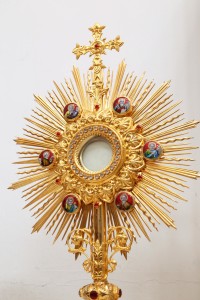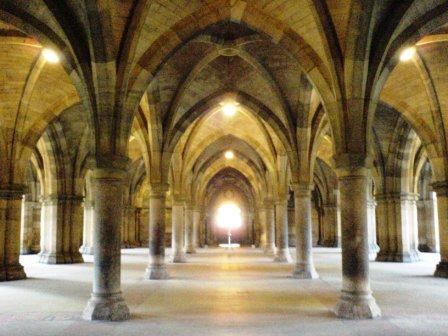This reflection is by Mike Eisenbath and was first published at the blog of the Catholic Writers’ Guild.
__
We call the drive time to and from work “rush hour,” but it can seem so much longer. We call social time with friends after the workday a “happy hour,” yet it feels much shorter when we’re having a good time. A college class, a grueling workout at the gym, a kids’ basketball or soccer game, all can last about an hour, though the quality can affect if that hour feels swift or tedious. Most recipes for lasagna call for an hour in the oven, painfully interminable if you’re really hungry.
A TV cop show takes an hour. A session with a mental health therapist lasts for an hour. And, of course, most Roman Catholics in the United States usually plan on an hour for Sunday Mass. Sure, it’s not always the case. Weekday Masses, without long communion lines and music, are shorter. Special Masses, such as Christmas and Easter Vigil, can take a good bit more time.
That leads me to wonder: Why does Mass have to last an hour?
For some people, that is far too time-consuming. I’m sure it did for the teenagers I saw across the aisle from me this morning. Their body language made it exceedingly clear the recessional song couldn’t come soon enough. I’m sure others, of all ages, find themselves thinking the same way while sitting in church pews from Honolulu to New York virtually every week. To them, Mass is insipid and mind-numbing; the prayers, songs and homilies strike them as painfully uninspiring, irrelevant, repetitive.
Wait. Perhaps you have the wrong idea. Allow me to ask that question again, in the way I actually meant: Why does Sunday Mass have to last only an hour? The Catechism of the Catholic Church calls the Mass “the source and summit of the Christian life.” As such, it should be the holiest hour of the 168 we receive each week. We should hunger for that hour, maybe even to the point of celebrating the Eucharist during the week.
The average American watches more than five hours of television every day. More than 18 million people spent an average of $84 apiece to watch an NFL game live in 2014, games that last three hours. The average American gamer spends more than six hours a week playing video games. People in the United States – which has been called “the fattest country in the world” – even spend more time weekly exercising (two hours a week) than faithful Catholics do at the most important activity in their lives.
“If it’s important, you’ll find a way,” millionaire entrepreneur Ryan Blair once said. “If it’s not, you’ll find an excuse.”
said. “If it’s not, you’ll find an excuse.”
I’m not going to lecture anyone about necessary improvements to the way we do liturgy in the American Church. In some respects, the quality of liturgy is in the soul of the beholder. There is no one-style-pleases-all Mass.
But Jesus is the same. The Real Presence is ever there. The faith is unchanging, ubiquitous in every church, at every Mass. Sadly, a fact of modern Catholic life is that not every person knows that faith, understands that faith, manifests that faith. Not only do many Catholics fail to embrace the Church’s teaching on the Real Presence, many don’t even know the Church teaches that. Perhaps most distressing, many Catholics never would claim any genuine relationship with Jesus – including a whole bunch sitting in a pew at a Sunday Mass near you.
Yet again I ask: Why does Mass have to last only an hour? Maybe there were logistical reasons once upon a time, when there were so many scheduled Masses each Sunday that they had to be spaced no more than 1½ hours apart. Our current relative shortage of priests coupled with the dramatically reduced Mass population means many churches have them spaced out two hours apart or more.
For a variety of reasons, the Catholics who do attend Mass consider it important; they found a way to be there. The Church thus has a somewhat captive audience, most of whom never will attend a Scripture study, prayer group, retreat, service project or other outreach of ministry the rest of the week. The Church could capitalize on the face-time opportunity to catechize and evangelize.
I’m not suggesting dramatic measures. How about five minutes before Mass begins to lead people in prayer designed specifically to prepare the hearts and minds for worship and reception of the Eucharist? Seize the moment to water the spiritual garden of thirsty souls. How about five to eight minutes right after distribution of Holy Communion for some catechism and evangelism? Train folks to explain Carmelite spirituality, for instance, or why the subject of religious freedom is so important to the Catholic Church, perhaps share some of the more fascinating stories about saints or elucidate the Church’s doctrine on Purgatory. Invite a recently baptized catechumen to proclaim what they love about their new Catholic faith or a member of a specific ministry to reveal their passion for the work they do.
Done well, the extra 10-15 minutes could lead to better understanding, deeper faith and maybe greater appreciation for the Eucharistic experience. To an engaged Catholic, a Mass lasting an hour and 15 minutes might actually feel shorter than the one-hour version that bores them today.
We call the drive time to and from work “rush hour,” but it can seem so much longer. We call social time with friends after the workday a “happy hour,” yet it feels much shorter when we’re having a good time. A college class, a grueling workout at the gym, a kids’ basketball or soccer game, all can last about an hour, though the quality can affect if that hour feels swift or tedious. Most recipes for lasagna call for an hour in the oven, painfully interminable if you’re really hungry.
A TV cop show takes an hour. A session with a mental health therapist lasts for an hour. And, of course, most Roman Catholics in the United States usually plan on an hour for Sunday Mass. Sure, it’s not always the case. Weekday Masses, without long communion lines and music, are shorter. Special Masses, such as Christmas and Easter Vigil, can take a good bit more time.
That leads me to wonder: Why does Mass have to last an hour?
For some people, that is far too time-consuming. I’m sure it did for the teenagers I saw across the aisle from me this morning. Their body language made it exceedingly clear the recessional song couldn’t come soon enough. I’m sure others, of all ages, find themselves thinking the same way while sitting in church pews from Honolulu to New York virtually every week. To them, Mass is insipid and mind-numbing; the prayers, songs and homilies strike them as painfully uninspiring, irrelevant, repetitive.
Wait. Perhaps you have the wrong idea. Allow me to ask that question again, in the way I actually meant: Why does Sunday Mass have to last only an hour? The Catechism of the Catholic Church calls the Mass “the source and summit of the Christian life.” As such, it should be the holiest hour of the 168 we receive each week. We should hunger for that hour, maybe even to the point of celebrating the Eucharist during the week.
The average American watches more than five hours of television every day. More than 18 million people spent an average of $84 apiece to watch an NFL game live in 2014, games that last three hours. The average American gamer spends more than six hours a week playing video games. People in the United States – which has been called “the fattest country in the world” – even spend more time weekly exercising (two hours a week) than faithful Catholics do at the most important activity in their lives.
“If it’s important, you’ll find a way,” millionaire entrepreneur Ryan Blair once
 said. “If it’s not, you’ll find an excuse.”
said. “If it’s not, you’ll find an excuse.”I’m not going to lecture anyone about necessary improvements to the way we do liturgy in the American Church. In some respects, the quality of liturgy is in the soul of the beholder. There is no one-style-pleases-all Mass.
But Jesus is the same. The Real Presence is ever there. The faith is unchanging, ubiquitous in every church, at every Mass. Sadly, a fact of modern Catholic life is that not every person knows that faith, understands that faith, manifests that faith. Not only do many Catholics fail to embrace the Church’s teaching on the Real Presence, many don’t even know the Church teaches that. Perhaps most distressing, many Catholics never would claim any genuine relationship with Jesus – including a whole bunch sitting in a pew at a Sunday Mass near you.
Yet again I ask: Why does Mass have to last only an hour? Maybe there were logistical reasons once upon a time, when there were so many scheduled Masses each Sunday that they had to be spaced no more than 1½ hours apart. Our current relative shortage of priests coupled with the dramatically reduced Mass population means many churches have them spaced out two hours apart or more.
For a variety of reasons, the Catholics who do attend Mass consider it important; they found a way to be there. The Church thus has a somewhat captive audience, most of whom never will attend a Scripture study, prayer group, retreat, service project or other outreach of ministry the rest of the week. The Church could capitalize on the face-time opportunity to catechize and evangelize.
I’m not suggesting dramatic measures. How about five minutes before Mass begins to lead people in prayer designed specifically to prepare the hearts and minds for worship and reception of the Eucharist? Seize the moment to water the spiritual garden of thirsty souls. How about five to eight minutes right after distribution of Holy Communion for some catechism and evangelism? Train folks to explain Carmelite spirituality, for instance, or why the subject of religious freedom is so important to the Catholic Church, perhaps share some of the more fascinating stories about saints or elucidate the Church’s doctrine on Purgatory. Invite a recently baptized catechumen to proclaim what they love about their new Catholic faith or a member of a specific ministry to reveal their passion for the work they do.
Done well, the extra 10-15 minutes could lead to better understanding, deeper faith and maybe greater appreciation for the Eucharistic experience. To an engaged Catholic, a Mass lasting an hour and 15 minutes might actually feel shorter than the one-hour version that bores them today.



